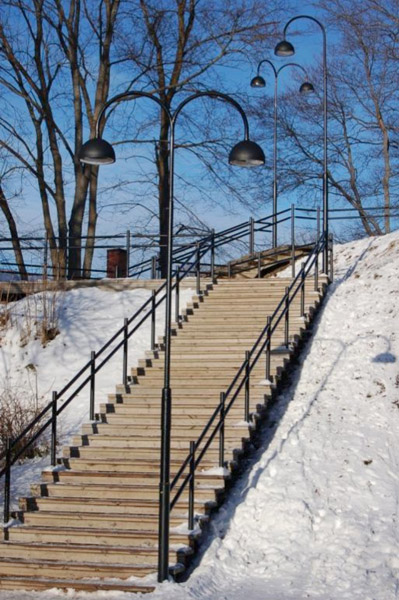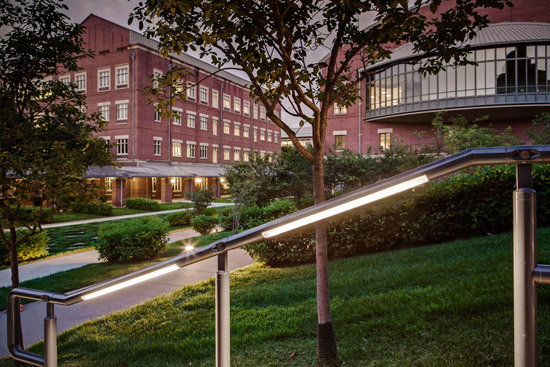Satisfying New Model Codes for Illuminating Steps, Ramps, and Paths of Egress
Potential Glare Issues
The light source in a bollard is typically high enough off of the ground to avoid obstruction by snow or leaves, reducing the likelihood that the light from the bollard will be entirely blocked by environmental debris. However, the height of the fixture places the light source more directly in the field of view of most occupants as they enter or exit the building, which means that bollards must be considered carefully, because they pose a serious risk of causing glare and discomfort.
Glare occurs when a source of light, or reflection of a light source, creates an excessively bright spot in the visual field which can cause distraction and discomfort. The IDA and the IES recognize that the potential of a bollard to create glare is dramatically reduced if the fixture does not emit spill light above the horizontal plane. Keeping light below the horizontal plane also limits the potential light pollution that could be contributed by the fixture.
Even if the selected bollard is designed not to emit light above the horizontal plane, it could still create glare, especially in applications with steps, where occupants could look directly up into the light source of the fixture as they climb the stairs. This potential threat of glare becomes even greater if the intensity of the light source is increased due to the need to increase the level of illumination the fixture provides at the walking surface.
Potential Spacing Issues
Attempting to use a bollard that was designed to meet traditional minimum illumination requirements to deliver the increased illumination levels at the walking surface will require a re-evaluation of the necessary spacing between the bollards. Generally speaking, using traditional bollards in this manner is not advised, because the fixtures would need to be placed so much more closely together that it would require a great deal more physical fixtures to complete the project. This approach could create visual clutter in the simple number of fixtures that would be installed in a space and it may be cost prohibitive.
Pedestrian Zone Pole Lights
Pedestrian pole lights are the most common way to illuminate exterior steps, ramps, and paths of egress. These pedestrian pole lights are distinguished from the pole lights typically specified for parking lots and roadways, because they are somewhat shorter, often measuring between 10 feet and 16 feet tall. The luminaire on a pole light sits atop the pole and is often more decorative than the luminaire found at the top of a pole in a parking lot or roadway, because it is thought that a passing pedestrian would be able to appreciate the greater aesthetic detail.
 |
Intense Lighting Photo courtesy of Intense Lighting |
Pole lights typically have a much larger distribution area than bollards or step lights and are available in CFL, high-intensity discharge (HID), high-pressure sodium (HPS), and LED lamp types.
Potential Glare Issues
The height of a pedestrian pole light, which places these light sources well within the visual field of most passersby, make glare control an important consideration. Where bollards can help control glare by not emitting light above the horizontal plane, and, instead, limiting the light distribution to the area that needs illumination, glare control in pole lights is slightly more involved. The challenge is that the pedestrians occupy the same area that needs to be illuminated, the area underneath the pole light. As designers begin to want greater illumination levels on the walking surface, it may require that the light source generate much more light, making the lamp even brighter, which will put it at an even greater risk for creating glare. Selecting pole lights with effective shielding is an important aspect of creating glare-free steps, ramps, and paths of egress and will become even more important if designs demand increased levels of illumination at the walking surface.
The Energy Use of Taller Exterior Fixtures
In terms of selecting energy efficient exterior fixtures, the selected light source, whether CFL, metal halide, LED, or something else makes a monumental impact on how much energy is required to provide the necessary illumination on the surface. The efficiency of the fixture, often impacted by the optical system within the fixture, also plays an important role. There is a variable, outside of the fixture components, that can also dramatically affect the energy required to meet illumination design goals, it is the distance of the light source from the surface it is illuminating.
Typically, it will require less energy to reach a particular illumination level the closer the light source is to the surface that needs to be illuminated. This is due, in large part, to the fact that as light travels, it illuminates everything in its path. If the light travels a shorter distance, less energy is spent illuminating the space between the light source and the intended surface.
Unfortunately, the height of a pole light can challenge the overall efficiency of the solution when compared to a shorter exterior fixture that positions the light source significantly closer to the walking surface it needs to illuminate.
An Illuminated Handrail
A relatively new innovation in exterior light fixtures is the illuminated handrail. This solution combines the handrails necessary at steps, ramps and paths of egress and the light source to provide the illumination on the walking surface into one exterior fixture. The illuminated handrail is a solid-state luminaire that uses LEDs to deliver uniform light on the walking surface in levels that exceed the 10 fc minimum now recommended by life safety codes written by ANSI and the NFPA.
 |
Sprint Campus: Kansas City, Missouri Photo courtesy of Intense Lighting |









